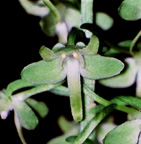Platanthera orbiculata (Pursh) Lindley
Large round-leaved orchid
The specific epithet orbiculata is the Latin meaning "round"
or "circular," in reference to the large, rounded leaves of this
species.


DESCRIPTION: Plant
glabrous, arising from a cluster of fleshy, thickened roots, 10-60 cm tall
(including inflorescence). Leaves 2 (1 in young, sterile plants),
opposite and basal (and typically pressed flat to the ground), orbicular
to broadly elliptical, 10-16 cm long and 10-15 cm wide, keeled, glossy and
somewhat fleshy; also typically 1-3 linear-lanceolate bracts higher up on
the stem. Inflorescence a loose or dense raceme, 10-30 flowered;
flowers greenish-white, very weakly fragrant, each flower subtended by a
lance-linear, acuminate bract. Lateral sepals ovate to ovate-lanceolate,
6-10 mm long and 4-7 mm wide, reflexed, and +/- falcate, colored as flowers;
dorsal sepal suborbicular, 4-8 mm long and 4-6 mm wide, colored as
flowers. Petals ovate-lanceolate and falcate, reflexed at the midpoint,
5-10 mm long and 2-4 mm wide. Labellum linear-oblong and obtuse,
9-20 mm long and 2-4 mm wide, colored as flowers; base of labellum with
a clubbed nectar spur projecting behind, 2-2.8 cm long.
SIMILAR SPECIES: Although the two are only vegetatively similar, Platanthera
orbiculata is often confused with P. hookeri
(usually by those who have never seen P. hookeri).
In bud or flower, the two are easily separated: P. orbiculata has
bracts on the stem of the inflorescence, while the stem of P.
hookeri lacks bracts. Apart from that, the flowers are quite different,
and flowering specimens should never be confused.
HABITAT: In Wisconsin, Platanthera orbiculata occurs in two types
of habitat: deeply shaded, rich mesic woods, and shaded to semi-open bogs.
It is most commonly found in the forested habitat, and along the coast of
Lake Superior and in the Apostle Islands, it may be abundant in mixed coniferous-deciduous
forest.
FLOWERING DATES: June 20-August 10.
POLLINATION: Warren Stoutamire (personal communication) has collected
two species of noctuid moths pollinating Platanthera orbiculata.
I have spent numerous hours in the field, including over 50 hours of light-trapping,
unsuccessfully trying to collect pollinators of this species. Luer
(1975) cites Sawyer (reference?) as identifying a hawkmoth (Sphinx
drupiferanum); however, this seems unlikely, as the proboscis length
of this moth (Reference?) is far too long for it to ever the contact the
pollinia (which are adapted to attach the eyes of the pollinator).
DISCUSSION: The basal leaves of this species restrict it to habitats
where it has little competition from other vegetation for light. This in
turn, tends to restrict Platanthera orbiculata to deeply shaded habitats.
This, in turn, probably also effects the frequency of flowering. P. orbiculata
plants tend to flower infrequently, probably as a consequence of the large
amount of energy required for flowering and the amount of time it would
require to accumulate such energy in the habitats where it typically occurs.
WI DISTRIBUTION:  U.S. DISTRIBUTION:
U.S. DISTRIBUTION:
Go directly to Wisconsin herbarium records.
Return
to the main LIST of the Orchids of Wisconsin.
Return to the main KEY to the Orchids of
Wisconsin.


 U.S. DISTRIBUTION:
U.S. DISTRIBUTION: